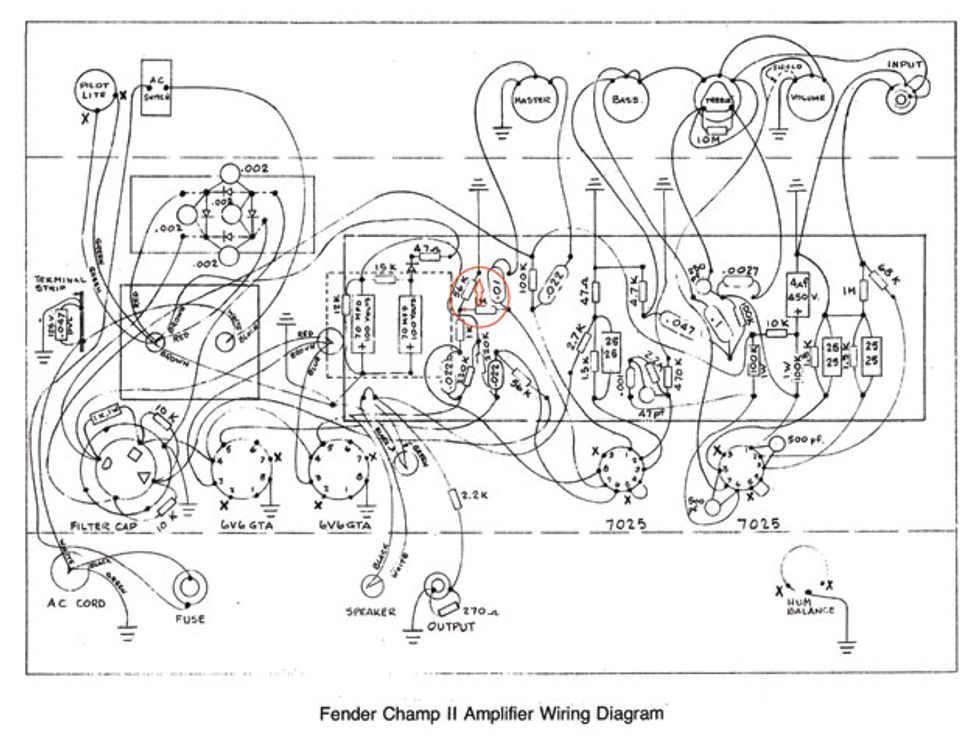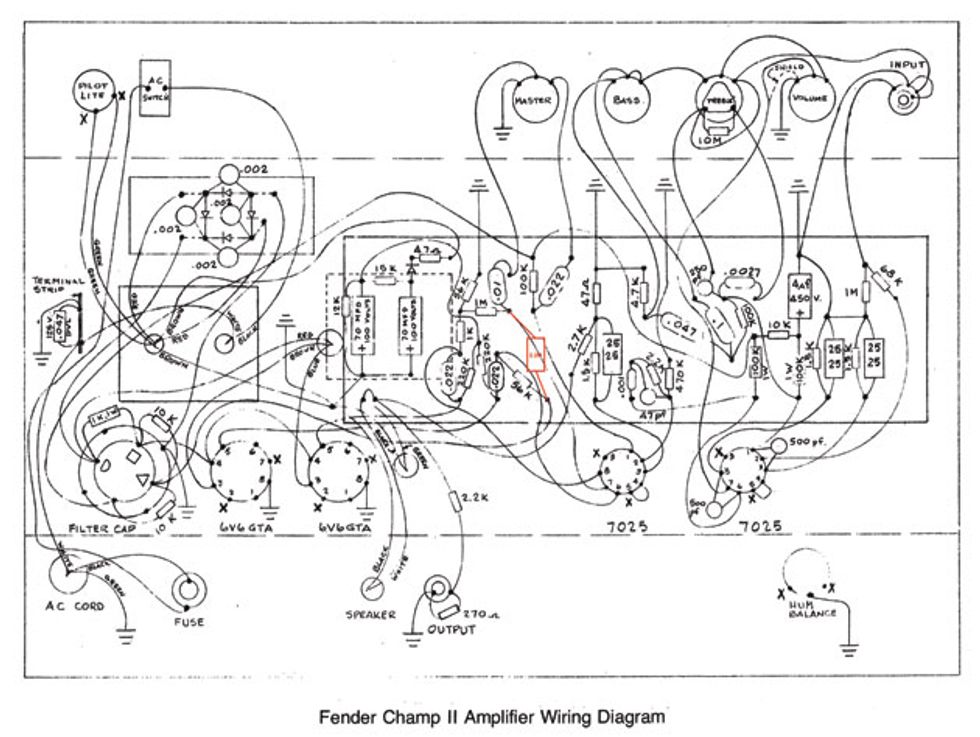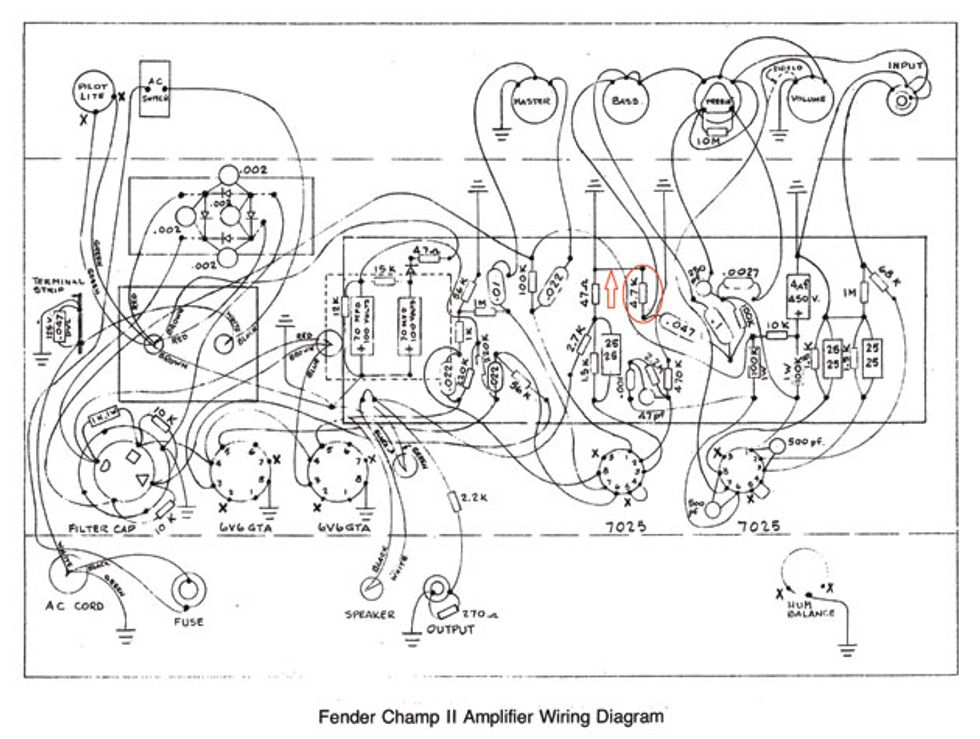Jeff,
I came across your article about the early Rivera/Fender Champ mod and was wondering if you knew much about the Champ II, which is an 18-watt, Princeton-like circuit. I’m looking for a good, shimmery clean platform that takes pedals well, but can turn the corner into tweed territory for the ultimate home jam/recording amp. (I’m looking for that “Wicked Game”/“Riviera Paradise”/“Wind Cries Mary” sound.) Right now the all-stock amp sounds good enough, but its “shimmer” isn’t quite there. I was considering buying a new 10" speaker for it, but I feel this would be a great amp to turn into a head unit to experiment with a variety of cabs, especially since it only cost me $300. I’d appreciate any insights you might have.
Brock
Hi Brock,
Thanks for your question. The Champ II is a cool little amp with quite a few modification possibilities, so let’s see what we can do.
You don’t see many Champ IIs, probably because it was apparently made for only two years—1982 and 1983. Its size might lead you to believe it’s nothing more than a standard Champ with an extra control, but it turns out size is about the only trait it shares with the ubiquitous Champ. The Champ II contains a healthier 10" speaker and is loaded with two 6V6 output tubes for a 12-watt wallop. This should be more than adequate for a home jam and recording amp, so let’s first see if we can add some shimmer.
In the schematic, note the two 500 pF ceramic capacitors (Image 1) at V1, one attached to pins 1 and 3 and the other to pins 6 and 8. These caps bleed off high frequencies. Typically caps like these are installed to prevent oscillation, but I don’t believe there’s enough gain in these amps to worry about that here. My theory is that they’re used to compensate for the bright guitars and strings of the era, or possibly to give the amp more of a singing midrange voice. Either way, they may be reducing the amp’s shimmer quality. Try lifting them one at a time and see what happens. You don’t need to fully remove them at first—just lift one leg of each. I’d do this at pin 1 and then pin 6. Be sure the amp is off and the filter caps are bled, as pins 1 and 6 are high-voltage points.
Image 2
Next, let’s look at the phase inverter stage. I’m going to suggest a mod to enhance the amp’s clean aspects by keeping the output signal more symmetrical at higher volumes. (I didn’t invent this mod—it’s been done for years in amps using a “cathodyne” phase inverter.) If you follow the wire connected to V2 pin 7 (grid), you’ll see it attaches to a .01 µf cap and a 1M resistor. Disconnect the 1M resistor from the junction of the 56k and 1k resistors and connect it to the opposite end of that same 56k resistor (Image 2). Now install one end of a new 2.7M resistor from the opposite end of the 1M resistor where it connects with the .01 µf cap.
Image 3
Almost directly across the board from this point is another 56k resistor. One end connects to V2 pin 6, and the other end connects to the large filter capacitor. Connect the other end of the 2.7M resistor to the filter cap end of the 56k resistor (Image 3). This sets a constant bias voltage on the grid of the phase inverter, keeping the signal more symmetrical at high signal levels. Some say that removing the asymmetry (uneven waveform) changes the character of the amp. But while asymmetrical clipping can have its place, as in the standard Champ, I believe this change will give the amp a bit more openness and possibly a truer response from pedals.
Image 4
Now let’s see if we can add a little tweed factor. If you follow the wire from the counterclockwise (CCW) leg of the bass pot, you’ll see it connects to a 4.7k resistor and .047 µf cap. The other side of that resistor connects to a jumper that goes to ground (Image 4). This resistor actually performs two tasks: First, it sets the amp’s midrange, like having a typical 10k mid control pot set at 5 on the front panel. (Increasing this value lets more mids through.) It also acts as a ground reference for the entire tone stack. Lifting this resistor from its ground connection effectively removes the tone stack from the circuit. And guess what? Tweed amps don’t have these tone stacks! (Yes, most have a tone control, but it’s completely different.) Because the tone stack robs a considerable amount of signal, removing it from the circuit substantially increases the amp’s gain. (In fact, this is actually used as a boost function in D-style and other amps.) Now, this won’t make the amp sound like a tweed and may not be a sound you want all the time, so you might consider having it as a switched option for that occasional extra push.
This is an amp that lends itself well to modification, and there are quite a few other mods you can experiment with, but I have to end it here. I hope these suggestions help take your Champ II to the next level.











![Rig Rundown: Russian Circles’ Mike Sullivan [2025]](https://www.premierguitar.com/media-library/youtube.jpg?id=62303631&width=1245&height=700&quality=70&coordinates=0%2C0%2C0%2C0)


























